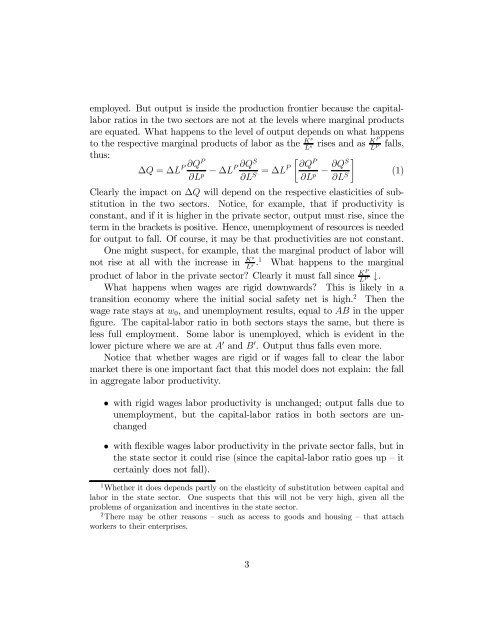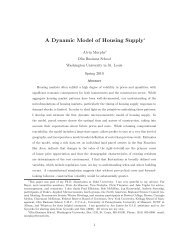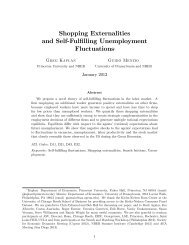Note on Adjustment and the Specific Factor Model
Note on Adjustment and the Specific Factor Model
Note on Adjustment and the Specific Factor Model
You also want an ePaper? Increase the reach of your titles
YUMPU automatically turns print PDFs into web optimized ePapers that Google loves.
employed. But output is inside <strong>the</strong> producti<strong>on</strong> fr<strong>on</strong>tier because <strong>the</strong> capitallaborratios in <strong>the</strong> two sectors are not at <strong>the</strong> levels where marginal productsare equated. What happens to <strong>the</strong> level of output depends <strong>on</strong> what happensto <strong>the</strong> respective marginal products of labor as <strong>the</strong> Ks rises <strong>and</strong> as KP falls,L sL Pthus:∆Q = ∆L P ∂QP∂L p∂QS− ∆LP∂L S= ∆LP ·∂QP∂L p¸− ∂QS∂L SClearly <strong>the</strong> impact <strong>on</strong> ∆Q will depend <strong>on</strong> <strong>the</strong> respective elasticities of substituti<strong>on</strong>in <strong>the</strong> two sectors. Notice, for example, that if productivity isc<strong>on</strong>stant, <strong>and</strong> if it is higher in <strong>the</strong> private sector, output must rise, since <strong>the</strong>term in <strong>the</strong> brackets is positive. Hence, unemployment of resources is neededfor output to fall. Of course, it may be that productivities are not c<strong>on</strong>stant.One might suspect, for example, that <strong>the</strong> marginal product of labor willnotriseatallwith<strong>the</strong>increasein Ks. 1 What happens to <strong>the</strong> marginalL sproduct of labor in <strong>the</strong> private sector? Clearly it must fall since KP ↓.L PWhat happens when wages are rigid downwards? This is likely in atransiti<strong>on</strong> ec<strong>on</strong>omy where <strong>the</strong> initial social safety net is high. 2 Then <strong>the</strong>wage rate stays at w 0 , <strong>and</strong> unemployment results, equal to AB in <strong>the</strong> upperÞgure. The capital-labor ratio in both sectors stays <strong>the</strong> same, but <strong>the</strong>re isless full employment. Some labor is unemployed, which is evident in <strong>the</strong>lower picture where we are at A 0 <strong>and</strong> B 0 .Outputthusfallsevenmore.Notice that whe<strong>the</strong>r wages are rigid or if wages fall to clear <strong>the</strong> labormarket <strong>the</strong>re is <strong>on</strong>e important fact that this model does not explain: <strong>the</strong> fallin aggregate labor productivity.• with rigid wages labor productivity is unchanged; output falls due tounemployment, but <strong>the</strong> capital-labor ratios in both sectors are unchanged• with ßexible wages labor productivity in <strong>the</strong> private sector falls, but in<strong>the</strong> state sector it could rise (since <strong>the</strong> capital-labor ratio goes up — itcertainly does not fall).1 Whe<strong>the</strong>r it does depends partly <strong>on</strong> <strong>the</strong> elasticity of substituti<strong>on</strong> between capital <strong>and</strong>labor in <strong>the</strong> state sector. One suspects that this will not be very high, given all <strong>the</strong>problems of organizati<strong>on</strong> <strong>and</strong> incentives in <strong>the</strong> state sector.2 There may be o<strong>the</strong>r reas<strong>on</strong>s — such as access to goods <strong>and</strong> housing — that attachworkers to <strong>the</strong>ir enterprises.(1)3
















